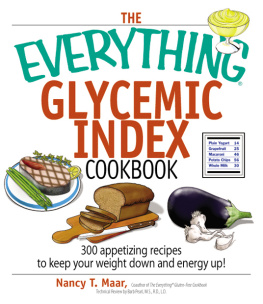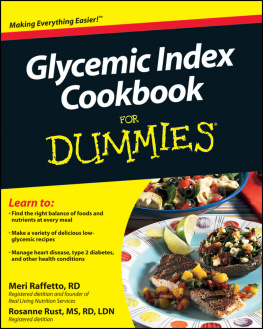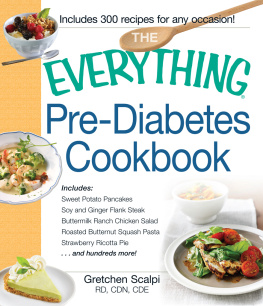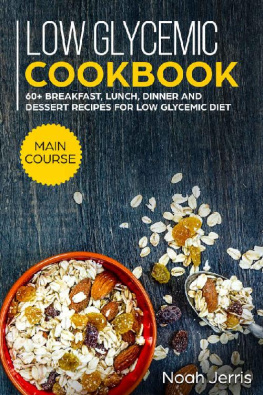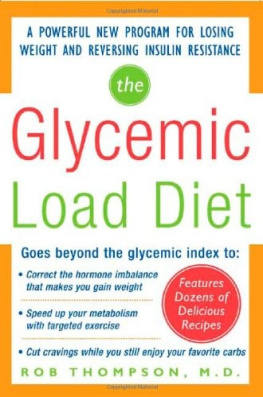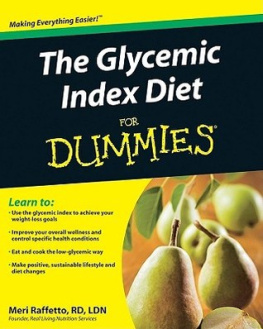the Glycemic LoadDiet Cookbook
the Glycemic Load Diet Cookbook
150 RECIPES TO HELP YOU LOSE WEIGHT
AND REVERSE INSULIN RESISTANCE
ROB THOMPSON, M.D. & DANA CARPENDER


Copyright 2009 by Dana Carpender and Robert Thompson, M.D. All rights reserved. Except as permitted under the United States Copyright Act of 1976, no part of this publication may be reproduced or distributed in any form or by any means, or stored in a database or retrieval system, without the prior written permission of the publisher.
ISBN: 978-0-07-159740-1
MHID: 0-07-159740-9
The material in this eBook also appears in the print version of this title: ISBN: 978-0-07-159739-5, MHID: 0-07-159739-5.
All trademarks are trademarks of their respective owners. Rather than put a trademark symbol after every occurrence of a trademarked name, we use names in an editorial fashion only, and to the benefit of the trademark owner, with no intention of infringement of the trademark. Where such designations appear in this book, they have been printed with initial caps.
McGraw-Hill eBooks are available at special quantity discounts to use as premiums and sales promotions, or for use in corporate training programs. To contact a representative please visit the Contact Us page at www.mhprofessional.com.
TERMS OF USE
This is a copyrighted work and The McGraw-Hill Companies, Inc. ("McGraw-Hill") and its licensors reserve all rights in and to the work. Use of this work is subject to these terms. Except as permitted under the Copyright Act of 1976 and the right to store and retrieve one copy of the work, you may not decompile, disassemble, reverse engineer, reproduce, modify, create derivative works based upon, transmit, distribute, disseminate, sell, publish or sublicense the work or any part of it without McGraw-Hill's prior consent. You may use the work for your own noncommercial and personal use; any other use of the work is strictly prohibited. Your right to use the work may be terminated if you fail to comply with these terms.
THE WORK IS PROVIDED "AS IS." McGRAW-HILL AND ITS LICENSORS MAKE NO GUARANTEES OR WARRANTIES AS TO THE ACCURACY, ADEQUACY OR COMPLETENESS OF OR RESULTS TO BE OBTAINED FROM USING THE WORK, INCLUDING ANY INFORMATION THAT CAN BE ACCESSED THROUGH THE WORK VIA HYPERLINK OR OTHERWISE, AND EXPRESSLY DISCLAIM ANY WARRANTY, EXPRESS OR IMPLIED, INCLUDING BUT NOT LIMITED TO IMPLIED WARRANTIES OF MERCHANTABILITY OR FITNESS FOR A PARTICULAR PURPOSE. McGraw-Hill and its licensors do not warrant or guarantee that the functions contained in the work will meet your requirements or that its operation will be uninterrupted or error free. Neither McGraw-Hill nor its licensors shall be liable to you or anyone else for any inaccuracy, error or omission, regardless of cause, in the work or for any damages resulting therefrom. McGraw-Hill has no responsibility for the content of any information accessed through the work. Under no circumstances shall McGraw-Hill and/or its licensors be liable for any indirect, incidental, special, punitive, consequential or similar damages that result from the use of or inability to use the work, even if any of them has been advised of the possibility of such damages. This limitation of liability shall apply to any claim or cause whatsoever whether such claim or cause arises in contract, tort or otherwise.
Dedicated to the memory of my father,
John Carpender. His eating habits were
disastrous, but his pride in my writing was
an endless source of joy.
Dana
To my wife, Kathy, for her support
and encouragement
Rob
Contents
Introduction
Welcome toThe Glycemic-Load Diet Cookbook
Carb Science: A Note from Dr. Rob
In the past, doctors took the old saying "You are what you eat" literally. They figured you got fat from eating fat and cholesterol buildup in your arteries from eating cholesterol. In the 1960s, scientists discovered a link between high blood cholesterol levels and heart disease and made an assumption that changed the way Americans ate for decades. They assumed, without proof, that high blood cholesterol came from eating too much cholesterol. Soon government agencies began telling people to eat fewer eggs and dairy products and less red meat. Low-cholesterol diets were supposed to be not only good for your arteries but also thriftier, kinder to animals, and friendlier to the planet. How could you go wrong?
Americans actually did as they were told. Average consumption of eggs, dairy products, and red meat declined steadily for three decades. The result? People kept right on having heart attacks. Following the advice to cut cholesterol had no effect on the incidence of heart disease. Research subsequently showed that low-fat, lowcholesterol diets are ineffective for preventing heart disease and don't even lower blood cholesterol levels much.
What doctors didn't know then that they know now is that most of the cholesterol in your blood does not come from food. Your liver makes about three times more cholesterol than you eat. If you eat less, it makes more. If you eat more, it makes less. In fact, most of the cholesterol you eat passes right through your digestive tract without being absorbed at all. It's not how much cholesterol you eat that determines your blood cholesterol level; it's how readily your body gets rid of it, and that's a genetic thing. When it comes to cholesterol, who your parents are is much more important than what you eat.
Actually, there's nothing inherently wrong with reducing your fat and cholesterol intake. The problem is, if you eat less of one kind of food, you usually end up eating more of another. Sure enough, when Americans started cutting down on eggs, meat, and dairy products, they began eating more carbohydrates, but not the healthful kindnot fresh fruits and vegetables. They started eating more starchand not just a little more but a lot more. By 1997, Americans were eating 48 percent more wheat, 186 percent more rice, and 131 percent more frozen potato products (read french fries) than they had in 1970.
That's a big change in eating behavior. You would expect it to have some effect. Indeed it dida bad one. The obesity rate skyrocketed in perfect tandem with the increasing carbohydrate consumption. By 1997, the percentage of Americans who were overweight had doubled; the diabetes rate, which tracks the obesity rate, tripled.
The old mantra "You are what you eat" is misleading. Your body can quickly turn carbohydrate to fat, fat to carbs, and both to cholesterol. You definitely do not need to eat fat to get fat. Refined carbohydrates like bread, potatoes, and rice actually have more potential to make you fat than fat itself does. These foods are full of starch, and as soon as starch reaches your digestive tract, it turns to sugar. Starch delivers more sugar into your bloodstream and does it faster than any other kind of food, including sugar itself. These blood sugar surges cause your body to produce huge amounts of insulin, a hormone that, in excess, is notorious for promoting weight gain.
Starch does another peculiar thing. It short-circuits into your bloodstream in the first foot or two of your intestine. Unlike most foods, it never traverses the last twenty feet, where several appetite-suppressing hormones come from. An hour or two after you eat it, you're hungry again.
Next page

